
ARCHIVES OF MECHANICS
Scope & Guideline
Exploring New Dimensions in Mechanics Since 1971
Introduction
Aims and Scopes
- Fluid Mechanics and Flow Dynamics:
Research in this area includes studies on Stokes flow, magnetohydrodynamic effects, and interactions between fluids and porous media, emphasizing the understanding of fluid behavior under various physical conditions. - Vibration and Stability Analysis:
This encompasses nonlinear and free vibration analyses of materials and structures, addressing stability issues in various mechanical systems, particularly those involving functionally graded materials. - Composite and Advanced Materials:
The journal highlights studies on functionally graded materials, nanocomposites, and the mechanical properties of various advanced materials, focusing on their behavior under stress and environmental influences. - Computational Mechanics and Modeling Techniques:
A significant aspect of the journal is dedicated to computational methods, including finite element modeling, peridynamics, and machine learning applications in mechanics, which facilitate the exploration of complex physical phenomena. - Thermoelasticity and Material Behavior:
Research on the thermal and mechanical behavior of materials, including studies on thermoelastic effects, heat conduction, and the impact of temperature on material properties is a core focus. - Experimental Mechanics and Validation:
The journal publishes experimental investigations that validate theoretical models and computational approaches, bridging the gap between theory and practical applications.
Trending and Emerging
- Functionally Graded Materials and Nanocomposites:
Research on functionally graded materials and nanocomposites is rapidly growing, driven by their unique properties and applications in aerospace, automotive, and structural engineering. - Machine Learning and Artificial Intelligence in Mechanics:
The integration of machine learning techniques for design optimization and predictive modeling is becoming a prominent theme, reflecting the industry's shift towards data-driven approaches. - Nonlinear and Dynamic Analysis:
There is an increasing focus on nonlinear dynamics and stability analysis, particularly in relation to complex materials and structures, underlining the need for advanced understanding in dynamic loading conditions. - Thermo-mechanical Behavior of Materials:
Research on the interaction between thermal and mechanical effects, especially in advanced materials, is gaining traction due to its relevance in high-performance applications. - Advanced Computational Techniques:
Emerging computational methodologies, such as peridynamic analysis and fractional derivative models, are trending, indicating a move towards more sophisticated tools for simulating complex material behavior.
Declining or Waning
- Traditional Elasticity Theories:
While still important, classical elasticity theories seem to have less frequent representation in recent publications, as researchers increasingly explore more complex, nonlocal, and advanced material models. - Basic Fluid Dynamics without Complex Interactions:
Studies focusing solely on basic fluid dynamics without considering interactions with complex materials or fields (like magnetic or thermal effects) are appearing less frequently as the field moves towards more interdisciplinary approaches. - Static Analysis of Conventional Structures:
Research focusing exclusively on static analysis of conventional structures, without considering dynamic effects or advanced materials, is waning as the demand for more comprehensive analyses grows. - Homogeneous Material Studies:
There is a noticeable decrease in studies examining homogeneous materials, with a growing emphasis on functionally graded and composite materials that better reflect real-world applications.
Similar Journals

International Journal of Mechanics and Materials in Design
Unveiling Insights in Mechanics and Materials for a Sustainable FutureInternational Journal of Mechanics and Materials in Design is a leading publication in the field of mechanical engineering and materials science, published by Springer Heidelberg. With an impressive impact factor, it holds esteemed rankings as Q1 in both Mechanical Engineering and Mechanics of Materials, and Q2 in Materials Science for the year 2023, solidifying its reputation as a significant contributor to the advancement of design methodologies. The journal focuses on the intersection of mechanics and materials, encouraging innovative research that addresses contemporary challenges faced in engineering disciplines. Researchers and professionals alike can benefit from accessing cutting-edge studies contributing to various applications, making it an invaluable resource for staying informed in this dynamic field. While the journal operates under a subscription model, its comprehensive reviews and high-quality original research foster a deeper understanding of material behavior and design principles, thus supporting the academic growth and professional development of its readers.
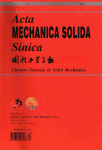
ACTA MECHANICA SOLIDA SINICA
Transforming Ideas into Engineering SolutionsACTA MECHANICA SOLIDA SINICA is a prestigious journal published by Springer, dedicated to advancing research in the fields of Computational Mechanics, Mechanical Engineering, and Mechanics of Materials. Since its inception in 1981, the journal has established a significant presence in the academic community, holding a commendable Q2 ranking across its categories as of 2023. Furthermore, it is recognized for its impactful contributions, with Scopus rankings placing it in the top quartiles, fostering essential discourse among professionals and researchers in the engineering domain. While it operates under a traditional access model, ACTA MECHANICA SOLIDA SINICA continues to provide valuable insights and developments, making it an essential resource for those seeking to deepen their understanding of solid mechanics and related disciplines. The journal remains an influential platform for innovative theoretical and experimental studies, reinforcing its status in the global academic landscape.
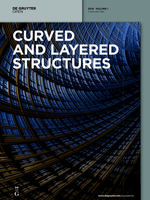
Curved and Layered Structures
Exploring the Intersection of Art and EngineeringCurved and Layered Structures, published by DE GRUYTER POLAND SP Z O O, is a distinguished open-access journal that has been an essential platform since 2014 for academics and professionals in the fields of Aerospace Engineering, Architecture, Building and Construction, Civil and Structural Engineering, and Computational Mechanics. With an ISSN of 2353-7396, it is recognized for its impactful contributions, reflected in its impressive category quartiles, particularly Q1 in Architecture and notable rankings in various engineering disciplines. The journal's scope encompasses innovative research focusing on the intricate designs and applications of curved and layered structures, making it pivotal for advancing knowledge in these areas. The open-access format ensures widespread dissemination of research findings, promoting accessibility and collaboration among researchers and practitioners worldwide. As it navigates its converged years from 2014 to 2024, Curved and Layered Structures continues to attract high-quality submissions that push the boundaries of engineering and architectural design.
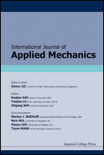
International Journal of Applied Mechanics
Advancing the Frontiers of Applied MechanicsThe International Journal of Applied Mechanics, published by World Scientific Publishing Co Pte Ltd, is a premier platform that serves the fields of materials science, mechanical engineering, and mechanics of materials. Located in Singapore, this journal has established itself as a crucial resource for researchers, professionals, and students, with its convergence of scholarly work from 2009 to 2024. Ranked in the Q2 category across notable disciplines, including Materials Science, Mechanical Engineering, and Mechanics of Materials, it reflects a strong commitment to publishing high-quality research that pushes the boundaries of knowledge in applied mechanics. Despite being a non-open access journal, its successful Scopus rankings, including an impressive rank of #151 in Mechanical Engineering, signify its substantial impact and recognition within the academic community. This journal not only aims to disseminate pioneering research but also to foster collaboration and innovation in the rapidly evolving landscape of applied mechanics.

Mechanical Sciences
Empowering researchers to share groundbreaking engineering insights.Mechanical Sciences is a prominent open-access journal published by COPERNICUS GESELLSCHAFT MBH since 2010, dedicated to advancing the field of mechanical engineering and its multidisciplinary applications. Operating from Göttingen, Germany, the journal has established a vital platform for researchers and professionals alike, facilitating the sharing of original research, reviews, and innovative methodologies across various domains, including civil and structural engineering, control and systems engineering, fluid flow, industrial engineering, and mechanics of materials. With a current impact factor placing it in the Q3 category across several engineering disciplines, Mechanical Sciences provides a valuable resource that not only highlights emerging trends but also contributes to the ongoing discourse within the engineering community. The journal's commitment to open access ensures that its content is widely accessible, encouraging collaboration and knowledge sharing among students, educators, and industry experts worldwide. As it continues to converge towards 2024, Mechanical Sciences remains an essential reference for anyone invested in the mechanics of engineering and related fields.
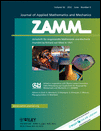
ZAMM-Zeitschrift fur Angewandte Mathematik und Mechanik
Elevating Knowledge in Applied Mathematics and Mechanics Since 1921.ZAMM-Zeitschrift fur Angewandte Mathematik und Mechanik is a distinguished journal published by WILEY-V C H VERLAG GMBH, committed to advancing the fields of applied mathematics and computational mechanics since its inception in 1921. With a significant trajectory spanning nearly a century, this journal serves as a critical platform for the dissemination of high-quality, peer-reviewed research that encompasses theoretical and practical advancements in these disciplines. Currently holding a Q3 category in Applied Mathematics and Q2 in Computational Mechanics as per the 2023 rankings, ZAMM demonstrates its prominence with measurable impact in both fields, reflected in its Scopus rankings: 202 out of 635 journals in Applied Mathematics and 32 out of 89 in Computational Mechanics. Although it does not provide open access, ZAMM remains invaluable to researchers, professionals, and students seeking to deepen their understanding and contribute to the evolving landscape of mathematical applications in engineering contexts. Explore the latest insights and methodologies that push the boundaries of applied mathematics and mechanics by engaging with ZAMM’s comprehensive range of articles.
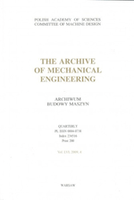
Archive of Mechanical Engineering
Connecting Scholars through Open Access InsightsThe Archive of Mechanical Engineering, published by Polska Akademia Nauk (Polish Academy of Sciences), is a distinguished platform for disseminating cutting-edge research in the fields of Mechanical Engineering and Mechanics of Materials. Since its inception, the journal has evolved and embraced an Open Access model since 2010, thereby enhancing accessibility and fostering wider dissemination of knowledge among researchers, professionals, and students globally. The journal covers a broad spectrum of topics, ensuring that vital advancements in mechanical engineering are communicated effectively. Recognized as a Q3 category journal in both its relevant categories as of 2023, the Archive continues to establish itself with a competitive Scopus Rank, aiming to elevate the standard of research and innovation. By merging historical insights with contemporary advancements, the journal serves as an essential resource for those seeking to delve into the evolution and future of mechanical engineering.
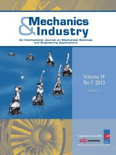
Mechanics & Industry
Innovating the Future of EngineeringMechanics & Industry, published by EDP SCIENCES S A, is a prominent open access journal dedicated to the fields of Industrial and Manufacturing Engineering, Materials Science, and Mechanical Engineering. Since its establishment in 2004, the journal has served as a crucial platform for disseminating innovative research and developments in mechanics, catering to a diverse audience of researchers, professionals, and students worldwide. With an ISSN of 2257-7777 and an E-ISSN of 2257-7750, the journal is indexed in Scopus and has achieved a respectable Q3 quartile ranking across its categories for 2023. Mechanics & Industry emphasizes the importance of collaborative research and the sharing of knowledge, underpinning advancements in technology and industry practices. The journal's commitment to open access ensures that research findings are available to all, promoting sustainability and innovation within the global engineering community. Located in Les Ulis, France, this journal continues to uphold high standards of scholarly excellence and relevance in an ever-evolving industrial landscape.
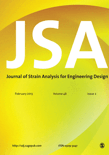
JOURNAL OF STRAIN ANALYSIS FOR ENGINEERING DESIGN
Elevating Engineering Standards through Rigorous Analysis.The Journal of Strain Analysis for Engineering Design, published by SAGE Publications Ltd, is a prestigious academic journal that has been at the forefront of *engineering and applied mathematics* research since its inception in 1965. With a focus on the intricate analysis of strain in engineering design, this journal serves as a vital resource for researchers and professionals seeking to push the boundaries of understanding in mechanics and materials engineering. As of 2023, it enjoys a respectable ranking in its respective fields, including Q2 in *Mechanical Engineering* and *Mechanics of Materials*, and Q3 in *Applied Mathematics* and *Modeling and Simulation*, reflecting its significant contribution to the academic community and relevance in practical applications. Although it is not an open-access journal, its rigorous peer-review process ensures the dissemination of high-quality research. The journal provides a platform for innovative ideas and methodologies, fostering advancements in engineering design and analysis vital for both academia and industry. By bridging theoretical foundations with real-world applications, the Journal of Strain Analysis for Engineering Design remains an essential publication for those dedicated to addressing the complexities of modern engineering challenges.
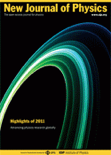
NEW JOURNAL OF PHYSICS
Connecting global minds through groundbreaking physics.NEW JOURNAL OF PHYSICS, published by IOP Publishing Ltd, is a prestigious open-access journal that has been at the forefront of the physics community since its inception in 1998. With an impact factor that places it in the Q1 category of Physics and Astronomy (miscellaneous) and a commendable ranking of #49 out of 243 in the general physics and astronomy category according to Scopus, this journal is recognized for its significant contribution to advancing research in the field. The journal caters to a broad scope of topics, providing a platform for the dissemination of cutting-edge research findings and innovative theoretical explorations. Operating from the United Kingdom, it offers a truly international perspective, making its contents accessible and impactful to a global audience. With robust open-access options, the NEW JOURNAL OF PHYSICS ensures that research findings are freely available, promoting collaboration and knowledge sharing among researchers, professionals, and students alike. This commitment to accessibility, combined with its high-quality content, makes it an essential resource for anyone engaged in the physics community.